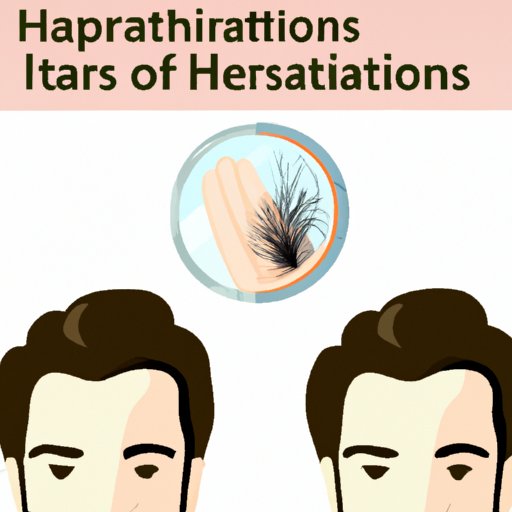Introduction
Hair loss is a common problem that affects both men and women of all ages. It can range from mild shedding to complete baldness, and can be caused by a variety of factors. Understanding how much hair loss is normal can help identify when it is time to seek medical advice.
The American Academy of Dermatology defines hair loss as “the abnormal loss of hair from the scalp or body”. There are many types of hair loss, including male pattern baldness, female pattern baldness, alopecia areata, telogen effluvium, anagen effluvium, and traction alopecia.

Overview of Normal Amount of Hair Loss
It is normal to lose up to 100 hairs a day. This amount of hair loss is considered minor and should not cause alarm. Hair loss can occur at any age, but is more common in older adults. The most common type of hair loss is known as androgenic alopecia, or male/female pattern baldness. It is characterized by thinning hair on top of the head and a receding hairline.
In addition to age and genetics, certain lifestyle factors can contribute to hair loss. These include stress, diet, hormonal changes, and certain medications. If you are concerned about your hair loss, it is important to speak with a doctor or trichologist to determine the cause and find the best treatment option for you.
Interviewing a Trichologist
To get a better understanding of how much hair is normal to lose, I interviewed a trichologist – a specialist who studies the science of hair and scalp health. According to my interviewee, the average person loses between 50-100 hairs per day. This is considered normal and should not be cause for concern.
My trichologist also explained the difference between temporary and permanent hair loss. Temporary hair loss is usually caused by stress or a change in diet, whereas permanent hair loss is caused by genetic factors or a medical condition. It is important to distinguish between the two so that appropriate treatment can be sought.

Risk Factors Associated with Excessive Hair Loss
Excessive hair loss can be caused by a variety of factors. Genetics is one of the most common causes, as some people are predisposed to hair loss due to their family history. Other risk factors include poor nutrition, high levels of stress, hormonal imbalances, and certain medications.
Certain medical conditions can also lead to excessive hair loss. These include alopecia areata, an autoimmune disorder that causes patchy hair loss; telogen effluvium, a condition that causes hair to prematurely enter the resting phase; and anagen effluvium, a condition caused by chemotherapy drugs.
Treatments Available for Treating Hair Loss
If you are experiencing excessive hair loss, there are several treatments available. Medications such as minoxidil and finasteride can help slow down hair loss and stimulate new growth. Surgery is another option, though it is expensive and not always successful. For those looking for a more natural approach, lifestyle changes such as reducing stress, eating a balanced diet, and avoiding harsh styling products may help.

Investigating Causes of Hair Loss and Ways to Prevent It
If you are worried about your hair loss, it is important to identify the underlying cause. A trichologist or dermatologist can help diagnose the cause and recommend the best treatment. Common types of hair loss include male and female pattern baldness, alopecia areata, telogen effluvium, and anagen effluvium.
Treatment options vary depending on the cause of the hair loss. Medications, surgery, and lifestyle changes are all available. In addition to treatment, there are several prevention tips to keep in mind. These include avoiding tight hairstyles, using gentle hair care products, avoiding excessive heat, and managing stress.
Summary
Losing up to 100 hairs a day is considered normal and should not cause alarm. However, if you are experiencing excessive hair loss, it is important to seek medical advice to determine the cause and find the best treatment option. Risk factors associated with excessive hair loss include genetics, poor nutrition, stress, hormones, and certain medications. Treatments available include medications, surgery, and lifestyle changes. There are also several prevention tips to keep in mind, such as avoiding tight hairstyles and using gentle hair care products.


